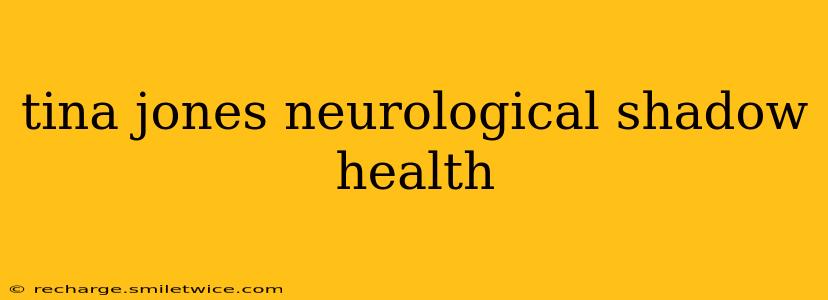Shadow Health Tina Jones presents a valuable opportunity for nursing and medical students to practice neurological assessments. This comprehensive guide will walk you through a virtual examination of Tina Jones, covering key aspects and providing insights into interpreting her findings. We will delve into the intricacies of the neurological exam, focusing on how to approach the assessment, what to look for, and how to document your findings accurately. This is not a substitute for hands-on clinical experience, but rather a supplementary tool for enhancing your learning and understanding.
What are the key components of a neurological assessment?
A complete neurological assessment encompasses a systematic evaluation of several key areas. These include:
-
Mental Status: Assessing level of consciousness, orientation, attention, memory, and cognitive function. With Tina Jones, this might involve questioning her about her current situation, recent events, and personal information.
-
Cranial Nerves: A systematic examination of twelve cranial nerves, assessing their function through various tests. For instance, you’ll assess visual acuity (II), pupillary responses (II, III), extraocular movements (III, IV, VI), facial strength (VII), hearing (VIII), and swallowing (IX, X).
-
Motor System: Evaluating muscle strength, tone, coordination, and gait. This may involve asking Tina Jones to perform actions like flexing and extending her limbs, assessing her reflexes, and observing her walking pattern.
-
Sensory System: Assessing the patient’s ability to perceive various sensory stimuli such as touch, pain, temperature, vibration, and proprioception. This requires testing different areas of her body and asking her to identify the sensations.
-
Reflexes: Evaluating deep tendon reflexes (DTRs) and superficial reflexes. This involves using a reflex hammer to test reflexes in different areas, such as the knee and ankle.
How do I perform a neurological assessment on Shadow Health Tina Jones?
Shadow Health provides a simulated environment for practicing clinical skills, including neurological assessments. To effectively assess Tina Jones neurologically, you must systematically proceed through each component mentioned above. The software will provide feedback on your techniques and interpretations, guiding you toward accuracy. Remember to:
- Follow a structured approach: Use a standardized neurological assessment format.
- Observe and document: Carefully observe Tina Jones’s responses and document your findings thoroughly.
- Interpret findings: Analyze the results and correlate them with potential diagnoses.
- Utilize the software features: Shadow Health provides tools like prompts and hints to guide you through the process.
What are some common neurological findings in Shadow Health Tina Jones scenarios?
The specific findings in Tina Jones's neurological assessment will vary depending on the assigned scenario. However, some common potential findings could include:
- Changes in mental status: Confusion, disorientation, or altered levels of consciousness.
- Abnormal cranial nerve findings: Weakness in facial muscles, decreased visual acuity, or abnormal pupillary responses.
- Motor deficits: Weakness, paralysis, or incoordination.
- Sensory deficits: Numbness, tingling, or loss of sensation.
- Abnormal reflexes: Hyperreflexia or hyporeflexia.
How do I interpret the results of the neurological exam in Shadow Health Tina Jones?
Interpreting the results requires careful analysis of all findings. Consider the pattern of abnormalities and correlate them with potential neurological conditions. It's crucial to consider:
- The location of any deficits: This can help localize the area of neurological dysfunction.
- The nature of the deficits: Are they focal, diffuse, or generalized?
- The time course of the deficits: Are they acute, subacute, or chronic?
This information, combined with Tina Jones's history and other clinical data, will help you reach a differential diagnosis.
What are the common neurological disorders that Tina Jones might present?
Shadow Health scenarios might present Tina Jones with various neurological conditions, such as:
- Stroke: A sudden disruption of blood supply to the brain.
- Head trauma: Injury to the brain resulting from an impact.
- Multiple sclerosis: An autoimmune disease affecting the central nervous system.
- Meningitis: Inflammation of the meninges surrounding the brain and spinal cord.
Remember, practicing with Shadow Health Tina Jones is crucial for developing your neurological assessment skills. Through repetition and careful observation, you can build confidence and improve your ability to identify neurological abnormalities. Always consult your course materials and seek guidance from your instructors for further clarification and assistance.
